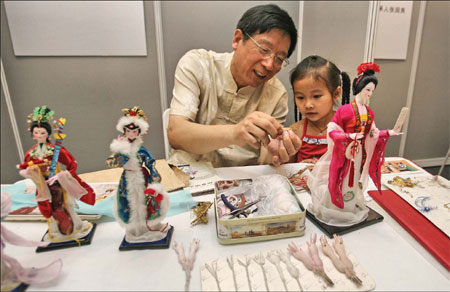Treasured toys
Updated: 2013-01-18 09:09
By Yin Yin (China Daily)
|
|||||||||||
|
A silk figurine artist demonstrates his skills of making Juanren, a silk doll that is recognized as a national treasure in China. Zhao Bing / for China Daily |
A silk doll first made in China more than a thousand years ago remains a popular fixture in many Chinese homes
Long-legged, fair-haired, and dressed in the most fashionable clothes, the Barbie doll has become an icon among children's toys in the West. But more than a thousand years ago a doll that swept China has just as much allure for youngsters.
Juanren, or silk doll, first appeared in the Han Dynasty (206 BC-AD 220), and remained popular across China for centuries.
They were designed with detailed facial expressions and could be found in most Chinese homes, placed inside their own special cabinet.
They were made of thin silk, gauze and damask silk and depicted both men and women from folktales, operas and traditional dramas. In many cases designers dressed them in the style of a particular ethnic group.
"Ancient Chinese fabric toys are very closely connected to silk figurines," says Zhong Bingtian, a researcher at the China Folklore Society.
"The evolution and development of silk and knitted goods has gone hand in hand."
Juanren has been through many phases of development. In the early Song Dynasty (960-1279), designers began to create clothes for the dolls, made from fine brocade.
In the Yuan Dynasty (1271-1368), they became an increasingly popular toy. And in the Ming Dynasty (1368-1644) the figurines began to appear depicting gods and goddesses from Chinese mythology.
"It was a folk tradition to make silk dolls to give to younger generations as a gift during the Dragon Boat Festival in many areas of southern China," Zhong says.
"And in the north, colorful silk and elegant satin were used to make the God of Felicity as a typical birthday present."
After the Qing Dynasty (1644-1911) Juanren fell from popularity as China became consumed in a series of wars and social unrest.
It was not until the mid-1950s that the artform was resurrected again when the government of the People's Republic of China was invited to attend an international toy fair in India.
Craftsmen were asked to make juanren for the fair and the government began promoting the craft as an important part of China's heritage. This spawned a resurgence in the popularity of silk dolls across China.
Li Yingdong, a Beijing silk figurine artist who has been engaged in the craft for more than 30 years, says: "In terms of materials, Beijing silk figurines are almost entirely made of Chinese silk from head to toe. The clothing, facial expressions and posture all emphasize Chinese characteristics."
"To make the elegant doll requires many careful steps, including carving, painting, sewing, dress-making, making accessories, creating props and designing headgear," Li says.
The head is made of clay and covered in fine silk threads to make a bun. Then iron wire, gauze and cotton are used to create a skeleton, skin and muscles.
Li particularly enjoys making the eyes, which he believes are the most important part of the design as they determine the facial expression and if well-made can create a lifelike quality. He is adept at creating various expressions in the eyes, including laughter, sorrow, a distant gaze and bravery.
"It's said that the eyes are the window to the soul," he says. "Through the eyes people can see the figurine's innermost being. To give a doll real character, the eyes are the most important part."
After creating the eyes, nose, mouth, ears and body, Li makes the hair using thin silk thread.
"Iron wire is used to make the skeleton, iron wire covered with antiseptic cotton is used to make the muscles, and gauze is used to shape the body. Similar procedures are use to make the hands, which require profound skill."
The designs are so intricate that making just one finger usually takes two or three days.
The final step, once the body is completed, is to make the clothes using silk and satin. These have to be researched to fit with the historical era the doll is depicting, Li says.
"Beijing silk figurines is a highly skilled art and still developing."
Today, juanren are recognized as a national Chinese treasure, and although their global popularity isn't perhaps on the scale of Barbie, they are once again a fixture in many Chinese homes.
yinyin@chinadaily.com.cn
(China Daily 01/18/2013 page26)
Today's Top News
Police continue manhunt for 2nd bombing suspect
H7N9 flu transmission studied
8% growth predicted for Q2
Nuke reactor gets foreign contract
First couple on Time's list of most influential
'Green' awareness levels drop in Beijing
Palace Museum spruces up
Trading channels 'need to broaden'
Hot Topics
Lunar probe , China growth forecasts, Emission rules get tougher, China seen through 'colored lens', International board,
Editor's Picks

|

|

|

|

|

|






